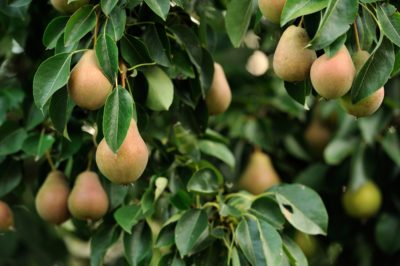Choosing A Tree
There are several things to think about when choosing which varieties to grow. When planting two for cross-pollination make sure the varieties are compatible and will pollinate each other.
- Tree Size – Full sized pear trees can reach 40 feet. Dwarf varieties are more suitable for smaller spaces.
- Disease Resistance – If you live in an area that is prone to disease, consider a resistant variety.
- Fruit Type – Some pears are better for fresh eating and others for cooking or canning. Choose varieties for what you like to do with them.
- Timing – Know when the tree will flower and fruit. Choose a variety with a desirable harvest date.
Planting
Choose your planting site. It will need a full sun location where it can be watered while it gets established. Dig a hole that is at least twice the size of the tree’s rootball. Mix several shovels full of compost into the hole.
It is ideal to plant pear trees while they are dormant and leafless. Spread the roots out evenly. Trim any roots that protrude beyond the hole edge or make it difficult to stand the tree up. Place the tree and fill in around it with loose earth. Lightly pack the soil down and water the tree in.
Pruning
Prune right after you plant the tree or during the first dormant season. Regular prunings should occur during late winter before the buds swell. Typically pear trees are pruned to a central leader. Prune to allow good airflow and sunlight into the center of the tree.
Remove branches that cross over each other and branches that come off the central leader at less than a 60-degree angle. Weak, narrow-angled branches will split when they get heavy with fruit. Remove all suckers from the base of the tree and from the crotches of branches.
Feeding and Harvest
Give trees a nutrient boost each spring. Add a three-to-six-inch layer of compost in a ring around the base of the tree or water with a compost tea. A mulch of wood chips, straw, or any other available organic matter can be added anytime.
Harvest pears when they are mature but not yet ripened. They are ready to pick when they come easily off the tree with a slight turning of the fruit. They will still be hard and possibly green. Ripen pears on the counter for five to seven days after picking.
